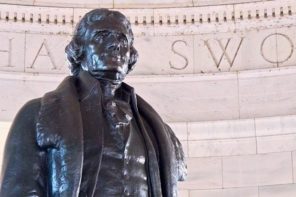A manifesto on religious freedom called The American Charter of Freedom of Religion and Conscience was rolled out at an invitation-only event at the National Archives Museum last week. Original copies of the Constitution and the Bill of Rights are on display in the museum’s “Rotunda for the Charters of Freedom,” but proximity to the founding documents of the United States and the founding-sounding name, were not enough to salvage a deeply-flawed initiative.
Behind earnestly worded appeals for religious toleration and respect is an exercise in historical revisionism—a pretense that the Framers of the Constitution and the First Amendment somehow intended the recently contrived deviations that now allow the idea of religious freedom to justify discrimination against others. As I reported for Religion Dispatches in October, behind the rhetorical bunting of the American Charter lies an effort to press the best of American democratic aspirations into the service of the religious and political agenda of the Christian Right and the Roman Catholic Bishops.
These things said, good faith efforts to seek compromise on difficult issues at the heart of our nation’s most democratic values, and to achieve greater civility in public life are good things. But they’re not ends unto themselves. And it’s certainly possible that some of those involved in the Charter initiative approach it in that spirit. That’s also why it’s important that people of good will take a hard look at this project with the idea that it may not be quite as benign as it first appears.
Briefly, let’s recall that the Charter advocates the core language of the Religious Freedom Restoration Act which lies at the core of so many contemporary issues, due largely to its role in the controversial 5-4 Supreme Court ruling in Hobby Lobby v. Burwell. But the Charter does not acknowledge this.
The Charter also presents itself as a solution to a problem that it can’t quite identify. The introduction declares that religious freedom is somehow imperiled by “current conflicts and confusions on both the Right and the Left.” But it neither identifies any of these conflicts, nor any of the entities involved. It further suggests that discussing the manifesto may help to restore an allegedly lost civility, though they fail to acknowledge the ways that calls for civility are themselves controversial. As Joshua DuBois warned at an American Charter event in 2017: “Civility has never saved us; it just makes us feel good while some others suffer.” Notably, DuBois, the former head of the Office of Faith-Based and Neighborhood Partnerships in the Obama White House, has yet to sign.
Whatever one may think of the American Charter Project, it has certainly not lived up to expectations. At a Brookings Institution event in Washington, DC in the Fall of 2017, William Galston, a co-chair of the project, said:
The American Charter Project will, before the end of the year, its backers and leaders fondly hope, release the American Charter of Religious Liberty. We hope to have a grand signing ceremony. We have outsized aspirations to get former presidents involved in the public exercise. So stay tuned, but we intend this to be as visible a restatement of the first principles of religious liberty as possible.
As we now know, the ceremony was held a year late, behind closed doors, in a museum, at night, with little fanfare and no press coverage.
While the signatories do reflect some ideological and religious diversity, they skew conservative, are notably thin on LGBTQ-rights advocates, and few of the hoped-for national figures Galston suggested are involved thus far.
Indeed, it appears the response to the Charter has been underwhelming. The list of signatories is padded with people directly affiliated with the sponsoring organization, the Religious Freedom Institute, whose leadership consists of five conservative Christians. Of the 75 original signatories, 13 are members of the staff, associated scholars, board or advisory board. The affiliations of 11 of those were not disclosed. If you add Project co-chairs William Galston and Os Guinness that’s 15 out of the original 75 signatories who are directly affiliated with the Institute.
When the big day finally arrived, two of the signatories, Charles Haynes and Oliver Thomas, announced the Charter in an op-ed in USA Today. The piece followed the Charter formula, including uplifting prose about what the Framers of the Constitution and the First Amendment intended about religious freedom, what it has meant in our history, and might mean for our future. But they make the same error as the Charter: They paraphrased the language of the Religious Freedom Restoration Act (RFRA) without acknowledging the source, leaving the impression that it’s not at the very core of contemporary disagreements about the meaning of religious freedom itself due in considerable part, to the Hobby Lobby case.
Signers of the charter recognize, of course, that there must be limits on the free exercise of religion. But they agree that ‘any substantial burden on the freedom of religion must be justified by a compelling governmental interest, and that the means chosen for serving that interest must be the least restrictive of freedom of religion.’
They go on to bemoan what they then characterize as:
… bitter debates over the relationship between claims of conscience and other fundamental rights such as equal protection, as in cases involving vendors and same-sex weddings.
According to the Religious Freedom Institute website, Thomas Farr and then-Templeton Foundation Vice President Kent R. Hill conceived a university-based project on religious freedom in 2010. The Foundation provided more than $3 million to the Religious Freedom Project through 2016, which was housed at the Berkley Center for Religion, Peace, and World Affairs at Georgetown University. Hill then joined Farr and other partners to found the Religious Freedom Institute, the organizational sponsor of the American Charter, which reports it received further funding from a mysterious entity called the Templeton Religion Trust, which is apparently part of a family of Templeton-related funds.
Part of the reason why the Charter initiative appears to be fizzling may be because people are not only increasingly skeptical of appeals to civility that tend to mute advocates for social justice (that I outlined previously), but because project leaders have not been friends of traditional approaches to church-state separation, having prominently led a war of attrition against Christian denominations that support it. These denominations also support reproductive rights and LGBTQ rights—and aspire to equality within their own communions. These denominations, the Episcopal Church, Presbyterian Church (USA), United Methodist Church, and United Church of Christ, have been leading members of the 38 member communions of the National Council of Churches.
Mainline leaders recognize that Religious Freedom Institute leaders, Executive Director Kent Hill, Chairman Thomas F. Farr, and signatory neoconservative Catholic Robert P. George have all played leadership roles in the neoconservative Institute on Religion and Democracy (IRD), which for a generation has sought to pit mainline Christians against one another as part of their effort to diminish the social justice witness of the mainline churches, promote schism, encourage congregations to leave denominations, and otherwise marginalize the central role these churches have played in American religious and public life. Hill was the IRD president of the Washington, D.C.-headquartered organization from 1986 to 1992. Thomas Farr is a current board member and George is a former longtime board member.
The conservative foundation-funded effort exploited the normal tensions of democratically run organizations for their own religious and political reasons.
Indeed, the American Charter talks a good game of seeking to foster mutual respect and tolerance in order to restore the supposedly “declining virtue of civility” and reduce societal polarization. But this does not mitigate the glaring problems at the heart of the Charter and the fact that the leaders of this effort have earned the mistrust that many are now showing them.




